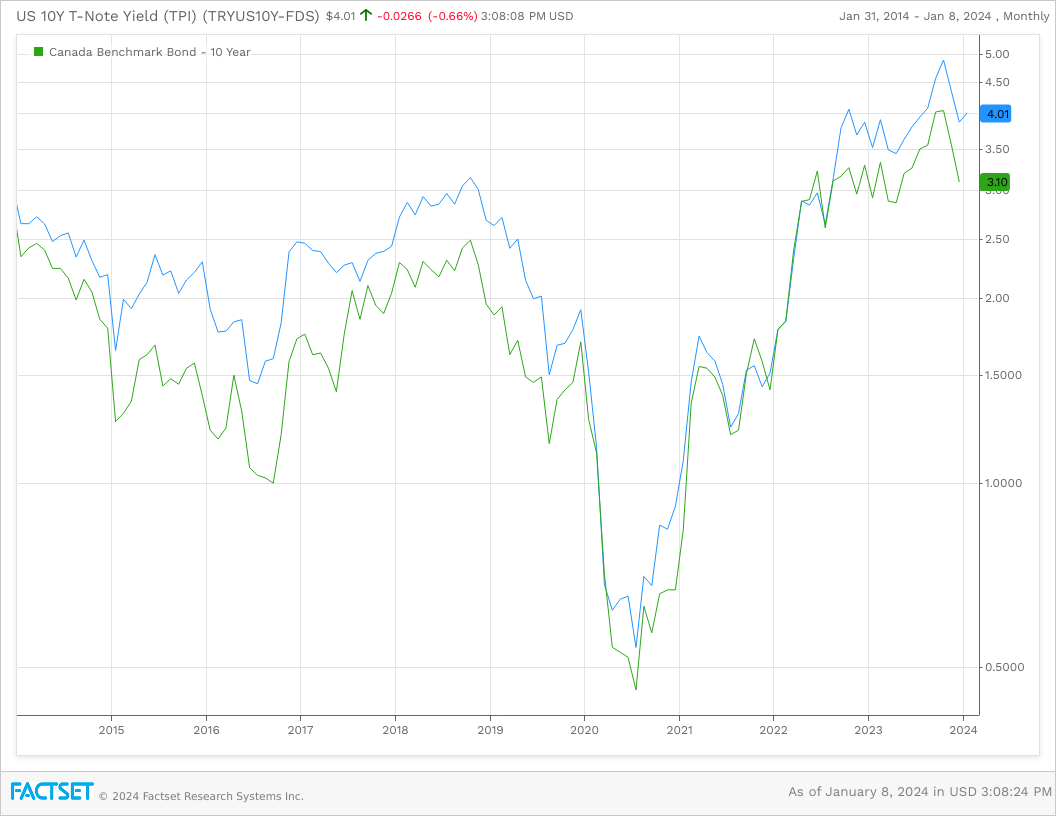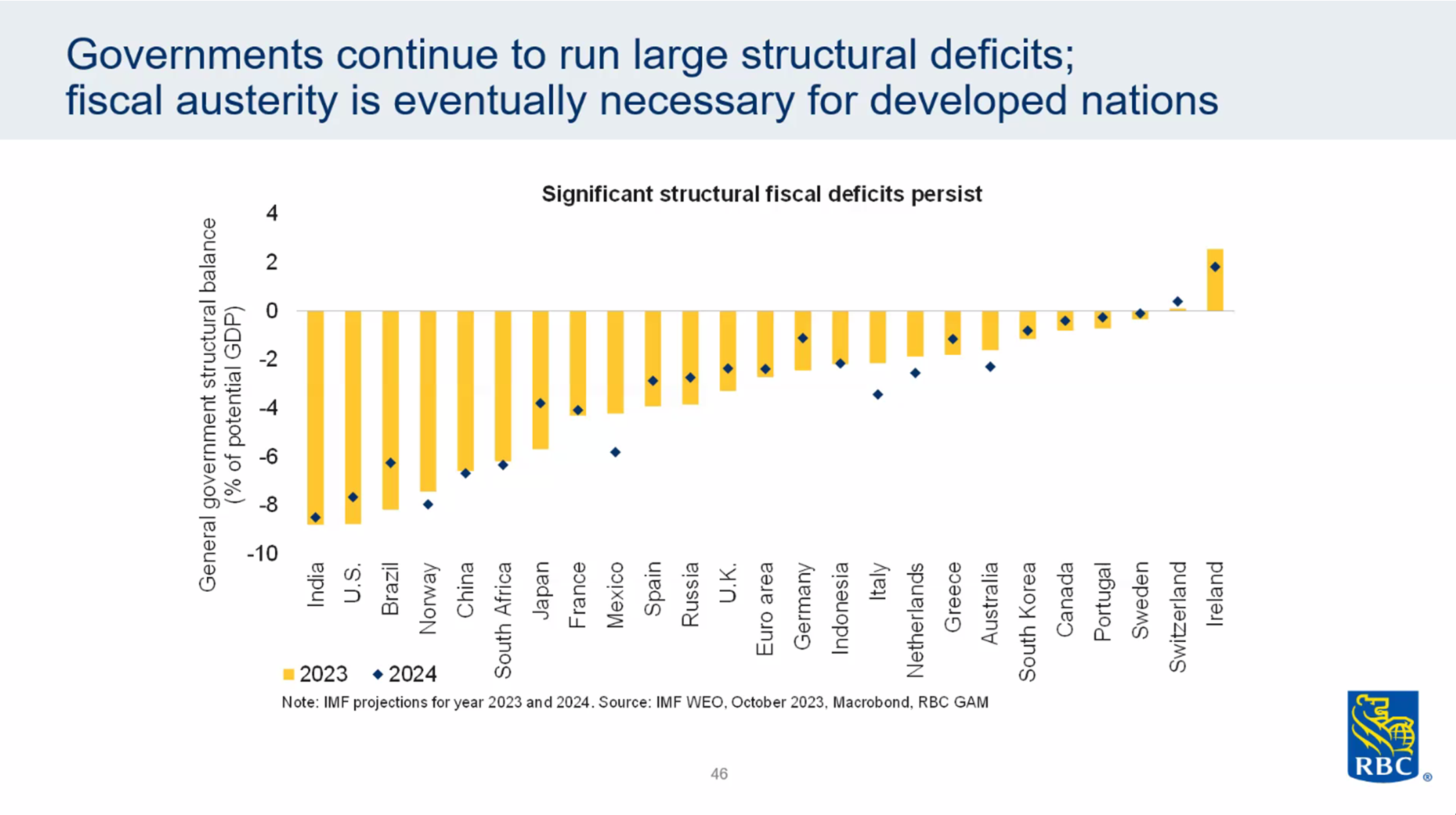Inflation has dropped throughout 2023 in most places as a result of central bankers’ interest rate increases and drawdown in the money supply. However, inflation remains above central banks’ target of 2% and, if globalization retreats, pressure on prices will remain.
A million seconds is 12 days, a billion seconds is 31 years, and a trillion seconds is 37,710 years, so the next time you hear a politician say they’re going to spend a billion or trillion dollars on this or that, we should ask who is going to pay for it. Our descendants are.
A famous economist once said that inflation is everywhere and always a monetary phenomenon. It is no wonder, then, that inflation rose as the world’s central banks printed billions following the financial crisis of 2008 and the pandemic of 2020-2021. The U.S. central bank’s balance sheet increased to four times its size following the financial crisis, and the pandemic stimulus increased it further. “Tapering” by the U.S. central bank over the past year has reduced its balance sheet, but left it almost double its size before the pandemic at $7.7 trillion.
The takeaway of this is that there remains a lot of excess monetary liquidity sloshing around the financial system bidding up asset prices. No wonder that investors prefer to own finite things like stocks of companies rather than cash or bonds that are printed out of thin air, billions or trillions at a time.
The world is polarizing again with two main camps emerging – the mainly western developed countries and the BRICS (Brazil, Russia, India, China and South Africa) alliance. The BRICS alliance includes Iran and North Korea, causing headaches for the West. The U.S. government has implemented the Inflation Reduction Act, which, in many ways, has the opposite effect of its title. Ostensibly intended to reduce inflation by bringing the manufacturing of key components home, it has morphed into trade barriers on computer chips from China, which is inflationary. The pandemic and its supply chain issues laid bare the vulnerability of free trade going too far. Perhaps this is the turning point for globalization and more trade tariffs are ahead.
Russia’s attack on Ukraine continues and little sign of a victor is apparent. Russia wants to ensure that Ukraine is aligned with it and the BRICS alliance and not with the West, as it looked ready to do before the attacks. Hamas’ attack in Israel was possibly timed to weaken U.S. support for Ukraine, and it looks like it may. Meanwhile, China clearly wants to annex Taiwan, but it needs to maintain access to consumers in the West who buy their manufactured goods. As well, North Korea continues to arm up and is fostering closer ties with Russia.
Inflation has dropped throughout 2023 in most places as a result of central bankers’ interest rate increases and drawdown in the money supply. However, inflation remains above central banks’ target of 2% and, if globalization retreats, pressure on prices will remain. Further, with governments facing massive debt loads, there is incentive for them to have inflation – borrow a dollar today and repay it with 70 cents later.
The U.S. Federal Reserve Governor, Jerome Powell, indicated in December that current interest rate increases were working and alluded that three interest rate cuts in 2024 were possible. Traders of stocks and bonds cheered leading to a strong rally in December. Whether his interest rate cuts comment was influenced by the upcoming U.S. elections in 2024, or whether he truly believes that inflation is tamed remains to be seen. Regardless, markets welcomed the prospect of the loosening of monetary conditions.
Climate change is a serious issue that is being addressed. However, it is largely being addressed by the developed Western countries and not by developing countries like China and India. China alone accounts for about 30% of the world’s greenhouse gasses, and they continue to build coal fired electric generation facilities. Meanwhile, governments in the West are intent on the electrification of everything – from cars to home heating. While this is admirable, it will require the massive buildout of electric generation and transmission, which will take many years. Wind and solar is playing, and will continue to play, a part in electricity generation, but atomic energy will likely play a big part as will natural gas turbines.
Beyond climate issues, there are many countries unhappy with their status in the world order. Meanwhile, many countries in the West have increased government borrowing – in many cases, to concerning levels. Adding to the complexity of major issues, about half of the world’s population is going to vote on governments in 2024, and many candidates will promise voters anything to get elected.
The challenges may seem daunting for the world at the moment, but we must remember that we have survived many other obstacles, such as world wars and recently a worldwide pandemic. Humans adapt and ingenuity helps us rise above obstacles. Companies are a group of people working together with a common goal and, as such, they too adapt and create solutions.
Overall, I suspect that we have entered a new long-term trend of an upward bias to inflation. While this may not be evident every year, as recessions inevitably occur, governments will prefer to keep economies growing and therefore keep money printing intact. All of this is good for many assets including some companies and well-located real estate.
However, with an inflationary bias, interest rates will remain elevated longer term. Because of this and the close relationship between the cost of money (interest rates) and stock prices, not all stocks will perform well. There are areas of the stock market that are over-valued unless interest rates return to and stay at near zero levels again.
We prefer quality companies in sectors that should do well, with good management, free cash flow and that are well capitalized. We believe this will protect savings over the long term. As always, we at Pringle Portfolio Management will do our best to protect your interests.
Tony Pringle, CFA
January 1, 2024


This information is not investment advice and should be used only in conjunction with a discussion with your RBC Dominion Securities Inc. Investment Advisor. This will ensure that your own circumstances have been considered properly and that action is taken on the latest available information. The strategies and advice in this report are provided for general guidance. Readers should consult their own Investment Advisor when planning to implement a strategy. Interest rates, market conditions, special offers, tax rulings, and other investment factors are subject to change. The information contained herein has been obtained from sources believed to be reliable at the time obtained but neither RBC Dominion Securities Inc. nor its employees, agents, or information suppliers can guarantee its accuracy or completeness. This report is not and under no circumstances is to be construed as an offer to sell or the solicitation of an offer to buy any securities. This report is furnished on the basis and understanding that neither RBC Dominion Securities Inc. nor its employees, agents, or information suppliers is to be under any responsibility or liability whatsoever in respect thereof. The inventories of RBC Dominion Securities Inc. may from time to time include securities mentioned herein. RBC Dominion Securities Inc.* and Royal Bank of Canada are separate corporate entities which are affiliated. *Member-Canadian Investor Protection Fund. RBC Dominion Securities Inc. is a member company of RBC Wealth Management, a business segment of Royal Bank of Canada. ® / TM Trademark(s) of Royal Bank of Canada. Used under licence. © 2022 RBC Dominion Securities Inc. All rights reserved. 22_90421_JTE_002 (06/22)

